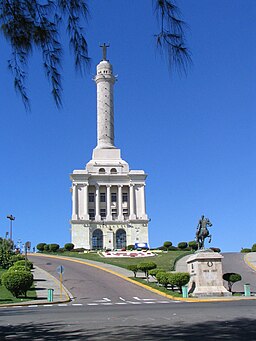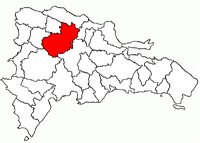Santiago (Dominican province)
| Santiago | |||
| Province | |||
|
Monument to the Heroes of the Restoration War
|
|||
|
|||
| Country | |||
|---|---|---|---|
| Capital | Santiago de los Caballeros | ||
| - elevation | 175 m (574 ft) | ||
| - coordinates | 19°28′48″N 70°41′24″W / 19.48000°N 70.69000°WCoordinates: 19°28′48″N 70°41′24″W / 19.48000°N 70.69000°W | ||
| Area | 2,806.29 km2 (1,084 sq mi) | ||
| Population | 1,503,362 (2014) | ||
| Density | 536/km2 (1,388/sq mi) | ||
| Province since | 1844 | ||
| Subdivisions | 10 municipalities 20 municipal districts |
||
| Congresspersons | 1 Senator 18 Deputies |
||
| Timezone | AST (UTC-4) | ||
| Area code | 1-809 1-829 1-849 | ||
| ISO 3166-2 | DO-25 | ||
| Postal Code | 51000 | ||
|
Location of Santiago Province
|
|||
| Website: www.provinciasantiago.gov.do/ | |||
Santiago (Spanish pronunciation: [sanˈtjaɣo]) is a province of the Dominican Republic, in the north of the country. Santiago is an intellectual, educational, and cultural center. It is also a major industrial center with rum, textile, cigarette and cigar industries based there. Shoe manufacturing, leather goods, and furniture making are important parts of the province's economic life. Santiago also has major Free Zone centers with four important industrial free zones; it also has an important cement factory. Santiago is home to one of the largest medical centers in the country, Clínica Unión Médica, which serves all 13 provinces of El Cibao.
Also within striking distance there are a good number of pleasant towns, many of which are quite prosperous. It is surrounded by tall mountains which have for years protected it from hurricanes and allows for dense tropical forests to develop on the slopes of such mountains, which are among the highest in the region.
The province as of June 20, 2006 is divided into the following municipalities (municipios) and municipal districts (distritos municipales – D.M.) within them:
The following is a sortable table of the municipalities and municipal districts with population figures as of the 2014 estimate. Urban population are those living in the seats (cabeceras literally heads) of municipalities or of municipal districts. Rural population are those living in the districts (Secciones literally sections) and neighborhoods (Parajes literally places) outside of them.The population figures are from the 2014 population estimate.
For comparison with the municipalities and municipal districts of other provinces, see the list of municipalities and municipal districts of the Dominican Republic.
...
Wikipedia




